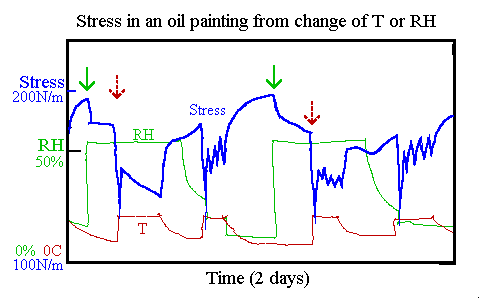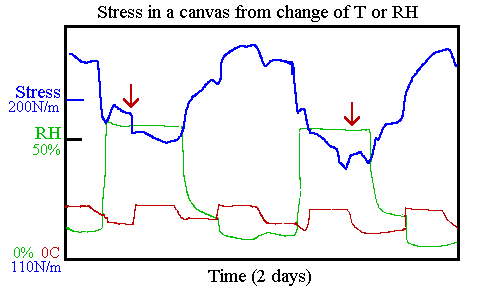
 |
Stress, strain and craquelure 5 |
The discussion so far has been limited to the rather theoretical abstraction of an oil painting without support. This is not entirely absurd. It turns out that an intact paint layer is stiffer than the canvas and is therefore the component that often bears most of the stress. The canvas is, at moderate RH, usually a passive observer of the drama of changing stress with changing environment, slackly following the instructions of the paint layer, or the glue sizing.

Figure 1 is adapted from an experiment by Gustav Berger and William Russell(1). It shows the stress built up across an oil painting by changes of RH and temperature that are large, but not unthinkable in everyday life. The green arrows show times when a sudden change of RH occured at a steady temperature and the red (broken) arrows mark when a sudden change of temperature occured at a steady RH.
It is immediately clear that the temperature change, typically between ten and twenty degrees, caused more change of stress than a RH change between 15 and 55%
This is a serious challenge to the prevailing orthodoxy: that conservators can be relatively careless about the temperature but must insist on a steady RH. Furthermore, the reaction to small, rapid temperature changes is disproportionately large. The effect of the rate of change of environmental variables is a subject that looms large in painting mechanics.

The situation was rather different when Berger and Russell scraped the paint off the canvas and repeated the experiment. Now the stress in the canvas is dominated by changing relative humidity. The influence of temperature changes (red arrows) is relatively small.
(1) Berger, Gustav A. and Russell, William H. Interaction between canvas and paint film in response to environmental changes, Studies in Conservation 39 (1994) 73-86.

This work is licensed under a Creative Commons Attribution-Noncommercial-No Derivative Works 3.0 License.